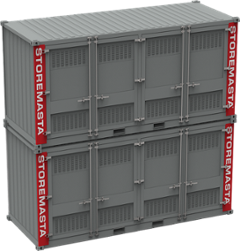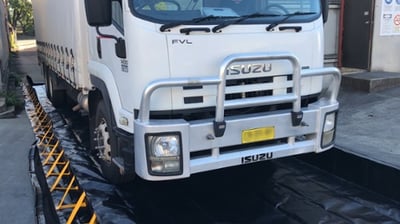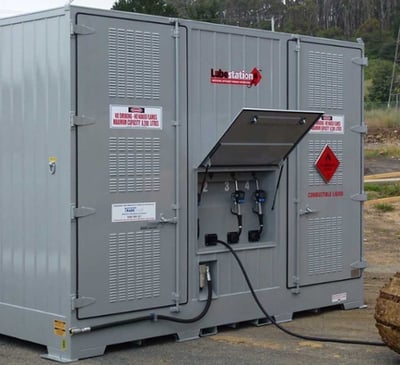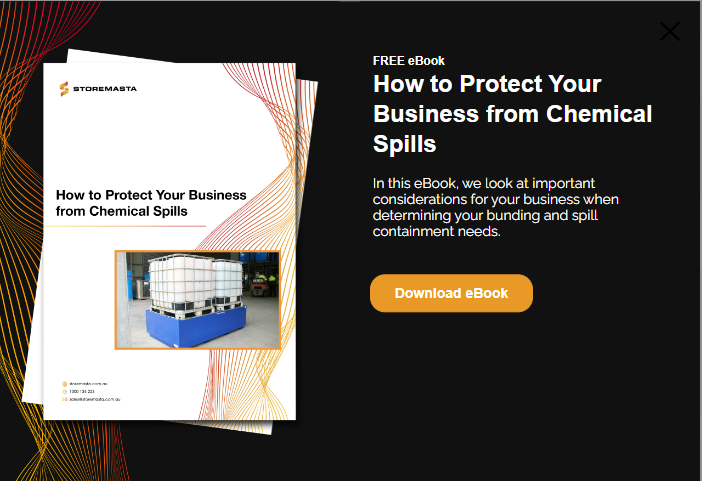Working with hazardous chemicals on remote job sites has its fair share of challenges, especially when it comes to the containment of chemical spills. However, there’s a range of bunding and chemical storage options that can help you prevent a HAZCHEM leak or spill from affecting the safety of your staff, operations and the environment. In this post, we break down the key spill containment measures that you can implement on your remote work site to help protect your business against the hazards associated with leaks and spillage.
Dangerous Goods Containers
Due to the difficulties with accessing remote sites, both the distance from major town centres as well as the harsh terrain, chemical storage must be designed and constructed to meet the needs of the site.
That means that chemical storage must be:
- Strong and durable
- Suitable for installation in extreme temperatures
- Able to withstand cyclonic conditions and storms
- Easily relocatable
- Adequately ventilated

You may install a relocatable dangerous goods container at your site for outdoor chemical storage of larger packages, drums and IBCs.
For the outdoor storage of hazardous chemicals, DG containers are the most viable option for remote work sites. These containers are designed for the safe storage of larger quantities of chemicals including toxic substances, corrosives and flammable liquids.
Some DG containers are designed to be stackable, which means that each container can be placed on top of another to maximise storage space within the footprint of the remote site. Stackable chemical storage containers can be used for unopened chemical packages, with the lower levels of containers (at ground level) suitable for chemical stores where packages may be accessed and opened regularly.
Another benefit of chemical storage containers is the fact that they are constructed to be moved. This means that they can be transported to the remote site via an array of transport options including truck, train or helicopter. Once transported to the site, the containers can then be lifted with a forklift or crane to a suitable position within the operations.

Relocatable dangerous goods containers are an ideal chemical storage choice for remote work sites.
Dangerous goods containers offer liquid-tight spill containment sumps which meet the chemical capacity requirements of the Australian Standards. Without this type of bunded storage, chemical packages, such as IBCs, drums or containers, may leak into the workplace and pose a risk to staff, property and the natural environment. Risks may include ignition (flammable liquids), corrosion (corrosive substances) or the poisoning of waterways and animal life (toxic chemicals).
REMEMBER: Each class of dangerous goods poses a different set of chemical hazards. In the event of a HAZCHEM leak or spill, staff must be aware of how to safely contain, manage, clean-up and dispose of the spilled chemicals as well as any resulting effluent.
Temporary Bunding
Remote sites are often heavily reliant on their fleet of vehicles due to the location of the site and the demands of the work operations. Mining, oil and gas, and other industrial sites in remote locations must be able to effectively contain chemical spills if they occur within the work environment or while their equipment and vehicles are in operation.
While bunded storage is designed to contain spillage within a chemical store, temporary bunding is another secondary spill containment option which is particularly useful on remote sites.

Portable bunding is particularly useful in remote operations where equipment, machinery and vehicles are regularly serviced, re-fueled or washed.
Temporary bunding is manufactured from heavy duty PVC or XR-5® membrane, with options to suit a variety of hazardous chemical substances.
Portable collapsible bunding can be a suitable solution for a range of applications including:
- Vehicle servicing or repair areas
- Equipment and vehicle wash bays
- Fuel transfer stations
- Decanting and chemical transfer operations
- Temporary chemical storage
Portable bunding offers the unique feature of being able to be set up and folded down in a quick timeframe, making it a good spill containment option for remote work sites. Temporary bunding may also be collapsed to allow for vehicles to be driven into and out of the bunding. This allows for any oil or fuel leaks or spills to be contained when machinery, equipment, cars and trucks are being utilized.
Lubrication Stations
One of the most significant spill risks on remote sites involves the transfer of hazardous chemicals, such as lubricants.
Maintaining equipment and vehicles requires the regular transferal of lubricating oils, to offset wear and tear from mechanical components. However, on remote sites, there are several key risks associated with this process, including the lubricant dispensing process, as well as the maneuvering of oil drums and the refilling of dispensing units.
You can reduce the risks associated with the dispensing of hazardous chemicals by opting for an all-in-one lubrication station.
To simplify this process, remote sites can choose to install an all-in-one lubricant dispensing system to allow for contamination-free dispensing. The unit holds a large volume of lubricating oil, which is seamlessly transferred through compliant dispensing equipment to the vehicles, machinery or equipment.
As it is constructed as a completely bunded system, the unit reduces the risk of leaks and spills by streamlining the whole lubrication dispensing process.
Decanting and Pumping
If your team are decanting and pumping hazardous chemicals, you can minimise the likelihood and impact of spillage by customising your outdoor chemical store with additional features.
Decanting systems and pump stations can be custom-built into outdoor storage containers and DG containers. These features effectively limit the risks associated with liquid chemical transfers and are particularly helpful when working in remote locations.
Physically decanting and pumping chemicals, without the use of a built-in system, can cause leaks and spills to occur in the workplace.
This is due to a range of factors including:
- Ill-fitting or non-compliant equipment
- Staff having to travel distances between storage and decanting/pumping areas
- The physical strain of moving chemical drums or packages
- Accidental spills occurring during the decanting or pumping process
By customising your outdoor chemical store with compliant decanting or pumping equipment, you are streamlining the chemical transferal process — and reducing the risk of hazardous chemical leaks and spills.
Handling Equipment
When chemical drums and containers are moved throughout a workplace, accidents and spillage can occur. On remote sites, it’s important that any transferal tasks are carried out in a safe and compliant manner. Chemical spills in an outdoor environment can quickly contaminate soil and waterways, posing hazards for wildlife and marine life in the location. Spillage can also result in fire or explosion if flammable liquids are involved.
To reduce these hazards, staff should be fully trained in HAZCHEM safety, as well as be supervised to ensure that chemical handling procedures are strictly followed.
However, due to the heavy lifting associated with the handling of chemical packages, staff must also be protected from injuring themselves during these handling tasks. Not only does injury affect the health and productivity of your workforce, it can also directly increase the risk of chemicals being dropped or spilled.
/Safe%20handling%20of%20chemicals%20in%20the%20workplace-600x300.jpeg?width=390&name=Safe%20handling%20of%20chemicals%20in%20the%20workplace-600x300.jpeg)
Providing the right chemical handling equipment, and ensuring its properly maintained, is essential for both the safety and efficiency of operations.
To safely transfer chemical packages in your workplace, you should consider bunded handling equipment. This may include the use of drum dollies, bunded trollies, mobile waste managers, and pallet racking.
Also consider other ways that you can reduce chemical spills at your site, including:
- Reducing the volume of chemicals kept onsite
- Reviewing and adjusting work procedures
- Updating equipment and storage
- Refresher training for staff
- Regular spill training for appropriate team members
- The inspection and maintenance of spill kits
- Reporting spill incidents and re-assessing risks
IMPORTANT: While it’s a requirement of WHS Regulations that all Australian workplaces that carry hazardous chemicals must be able to contain and manage chemical spills, it’s also important to understand that you’re legally obliged to maintain your equipment. This includes the inspection and maintenance of chemical stores, decanting and pumping equipment, transfer equipment and trollies, and chemical spill kits.
Bunded Storage
From drip trays to bunded pallets, there are a multitude of bunding options that you can implement to improve the safety of your site.
Bunding options may include:
- Drum bunds – oil drum bunded storage offers a bunded base to store drums in an indoor or outdoor environment
- IBC bunds – for organisations that carry large volumes of hazardous chemicals, IBC bunded pallets provide protection against spillage, allowing for a safer chemical dispensing process
- Steel bunds – suitable for use with Class 3 Flammable Liquids, steel bunds are non-combustible, chemically-resistant bunds that prevent spillage — and reduce the risk of fire and explosion
- Floor bunding – floor bunds provide a secondary containment system which prevents liquids from seeping into the workplace or natural environment
- Drip trays –drip trays are useful when working with vehicles or in situations where only small volumes of hazardous chemicals may be released. However, they must never be used as the sole spill containment measure, but only an additional containment option
Safely Containing Spills On Remote Work Sites
While it’s an obligation under WHS Regulations and Australian Standards to prevent, contain and manage spills, it’s often a complex process that involves a range of bunded options – as well as strict procedures, staff training and ongoing risk assessments.
As we’ve highlighted in this blog, remote sites can benefit from the installation of a range of chemical bunding solutions, including dangerous goods containers, portable spill bunds, bunded handling equipment, and drum and IBC bunded storage.
To learn more about protecting your site from the hazards associated with chemical spills, why not download our latest eBook? Our guide will help you determine your spill containment needs and offers expert advice on how to reduce chemical risk within your operations. Click on the image below to access your copy of our eBook today.
Joining the team as a Dangerous Goods Storage Consultant, Melissa Hampton became Storemasta's Marketing Manager in late 2021. With extensive knowledge and experience in chemical compliance, Melissa is responsible for leading the Marketing team and helping shape their marketing strategy. In her spare time, you can find Melissa hiking, swimming and enjoying the great outdoors in beautiful north-west Tasmania.

